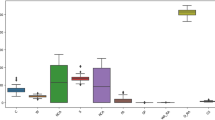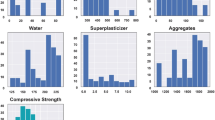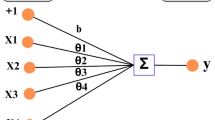Abstract
Sandcrete blocks are popular for construction but their production relies on cement, which is a major contributor to greenhouse gases. Rice husk ash (RHA), a waste product, can partially replace cement in sandcrete blocks. This study uses machine learning (ML) to predict the compressive strength of these blocks, which is influenced by factors such as the ratio of fine aggregate to binder, RHA to binder ratio, water-to-binder ratio, and curing time. The data were collected from published literature on factors affecting compressive strength from various sources and analyzed 795 observations. The analysis showed that strength increases with longer curing but decreases with higher ratios of aggregate-to-binder, RHA-to-binder, and water-to-binder. The data were divided for training and testing ML models. Five algorithms were investigated, and the eXtreme Gradient Boosting (XGB) model emerged as the best for predicting compressive strength. The XGB model strongly correlated with predicted and measured strength, with an R2 value of 0.94 for training data and 0.89 for testing data. It also displayed lower error metrics compared to other models. XGB's success is due to its ability to handle complex relationships and prevent overfitting. This study highlights the potential of ML for predicting the strength of RHA-blended sandcrete blocks.








Similar content being viewed by others
References
Akanbi, O. A., Amiri, I. S., & Fazeldehkordi, E. (2015). Chapter 3 - Research Methodology. In O. A. Akanbi, I. S. Amiri, & E. Fazeldehkordi (Eds.), A Machine-Learning Approach to Phishing Detection and Defense (pp. 35–43). Syngress.
Amran, M., Fediuk, R., Murali, G., Vatin, N., Karelina, M., Ozbakkaloglu, T., Krishna, R. S., Sahoo, A. K., Das, S. K., & Mishra, J. (2021). Rice husk ash-based concrete composites: a critical review of their properties and applications. Crystals. https://doi.org/10.3390/cryst11020168
Anburuvel, A., Sathiparan, N., Dhananjaya, G. M. A., & Anuruththan, A. (2023). Characteristic evaluation of geopolymer based lateritic soil stabilization enriched with eggshell ash and rice husk ash for road construction: An experimental investigation. Construction and Building Materials, 387, 131659.
Antiohos, S. K., Papadakis, V. G., & Tsimas, S. (2014). Rice husk ash (RHA) effectiveness in cement and concrete as a function of reactive silica and fineness. Cement and Concrete Research, 61–62, 20–27.
Anžel, A., Heider, D., & Hattab, G. (2023). Interactive polar diagrams for model comparison. Computer Methods and Programs in Biomedicine, 242, 107843.
Bassi, A., Manchanda, A., Singh, R., & Patel, M. (2023). A comparative study of machine learning algorithms for the prediction of compressive strength of rice husk ash-based concrete. Natural Hazards, 118, 209–238.
Belaïd, F. (2022). How does concrete and cement industry transformation contribute to mitigating climate change challenges? Resources. Conservation & Recycling Advances, 15, 200084.
Dolage, D. A. R., Mylvaganam, K., Mayoorathan, P., & Inparatnam, S. (2011). Use of rice husk ash blended cement to produce cement sand blocks: Optimal level of cement replacement for compressive strength. Engineer, 44, 11–19.
Emeka, O. H., & Lawrence, O. (2021). Compressive strength of sandcrete containing rice husk ash obtained from different calcinations methods. International Refereed Journal of Engineering and Science, 6, 71–74.
Ettu, L. O., Ajoku, C. A., Nwachukwu, K. C., Awodiji, C. T. G., & Eziefula, U. G. (2013). Strength variation of OPC-rice husk ash composites with percentage rice husk ash. International Journal of Applied Sciences and Engineering Research, 2, 420–424.
Fapohunda, C., Akinbile, B., & Shittu, A. (2017). Structure and properties of mortar and concrete with rice husk ash as partial replacement of ordinary Portland cement – A review. International Journal of Sustainable Built Environment, 6, 675–692.
Feng, D.-C., Liu, Z.-T., Wang, X.-D., Chen, Y., Chang, J.-Q., Wei, D.-F., & Jiang, Z.-M. (2020). Machine learning-based compressive strength prediction for concrete: An adaptive boosting approach. Construction and Building Materials, 230, 117000.
Gao, W., Karbasi, M., Derakhsh, A. M., & Jalili, A. (2019). Development of a novel soft-computing framework for the simulation aims: A case study. Engineering with Computers, 35, 315–322.
Gowda, M. R., Narasimhan, M. C., & Karisiddappa, n.,. (2011). Development and study of the strength of self-compacting mortar mixes using local materials. Journal of Materials in Civil Engineering, 23, 526–532.
Huang, Y., Lei, Y., Luo, X., & Fu, C. (2023). Prediction of compressive strength of rice husk ash concrete: A comparison of different metaheuristic algorithms for optimizing support vector regression. Case Studies in Construction Materials, 18, e02201.
Jamil, M., Kaish, A. B. M. A., Raman, S. N., & Zain, M. F. M. (2013). Pozzolanic contribution of rice husk ash in cementitious system. Construction and Building Materials, 47, 588–593.
Jamil, M., Khan, M. N. N., Karim, M. R., Kaish, A. B. M. A., & Zain, M. F. M. (2016). Physical and chemical contributions of Rice Husk Ash on the properties of mortar. Construction and Building Materials, 128, 185–198.
Jittin, V., Bahurudeen, A., & Ajinkya, S. D. (2020). Utilisation of rice husk ash for cleaner production of different construction products. Journal of Cleaner Production, 263, 121578.
Kashem, A., Karim, R., Das, P., Datta, S. D., & Alharthai, M. (2024). Compressive strength prediction of sustainable concrete incorporating rice husk ash (RHA) using hybrid machine learning algorithms and parametric analyses. Case Studies in Construction Materials, 20, e03030.
Kaveh, A., Dadras Eslamlou, A., Javadi, S. M., & Geran Malek, N. (2021). Machine learning regression approaches for predicting the ultimate buckling load of variable-stiffness composite cylinders. Acta Mechanica, 232, 921–931.
Kaveh, A., & Khavaninzadeh, N. (2023a). Efficient training of two ANNs using four meta-heuristic algorithms for predicting the FRP strength. Structures, 52, 256–272.
Kaveh, A., & Khavaninzadeh, N. (2023b). Hybrid ECBO–ANN Algorithm for Shear Strength of Partially Grouted Masonry Walls. Periodica Polytechnica Civil Engineering, 67, 1176–1186.
Kaveh, A., Mohammad Javadi, S., & Mahdipour Moghani, R. (2022). Shear Strength Prediction of FRP-reinforced Concrete Beams Using an Extreme Gradient Boosting Framework. Periodica Polytechnica Civil Engineering, 66, 18–29.
Kaveh, A., & Zolghadr, A. (2014). Democratic PSO for truss layout and size optimization with frequency constraints. Computers & Structures, 130, 10–21.
Khan, W., Fahim, M., Zaman, S., Khan, S. W., Badrashi, Y. I., & Khan, F. (2021). Use of Rice Husk Ash as Partial Replacement of Cement in Sandcrete Blocks. Adv. Sci. Technol. Res. J., 15, 101–107.
Kumar Das, S., Adediran, A., Rodrigue Kaze, C., Mohammed Mustakim, S., & Leklou, N. (2022). Production, characteristics, and utilization of rice husk ash in alkali activated materials: An overview of fresh and hardened state properties. Construction and Building Materials, 345, 128341.
Mahasenan, N., Smith, S., & Humphreys, K. (2003). The Cement Industry and Global Climate Change: Current and Potential Future Cement Industry CO2 Emissions. In J. Gale & Y. Kaya (Eds.), Greenhouse Gas Control Technologies - 6th International Conference (pp. 995–1000). Pergamon.
Malami, S. I., Musa, A. A., Haruna, S. I., Aliyu, U. U., Usman, A. G., Abdurrahman, M. I., Bashir, A., & Abba, S. I. (2022). Implementation of soft-computing models for prediction of flexural strength of pervious concrete hybridized with rice husk ash and calcium carbide waste. Modeling Earth Systems and Environment, 8, 1933–1947.
Marani, A., & Nehdi, M. L. (2020). Machine learning prediction of compressive strength for phase change materials integrated cementitious composites. Construction and Building Materials, 265, 120286.
Mayooran, S., Ragavan, S., & Sathiparan, N. (2017). Comparative study on open air burnt low- and high-carbon rice husk ash as partial cement replacement in cement block production. Journal of Building Engineering, 13, 137–145.
Montesinos López, O. A., Montesinos López, A., & Crossa, J. (2022a). Fundamentals of Artificial Neural Networks and Deep Learning. In O. A. Montesinos López, A. Montesinos López, & J. Crossa (Eds.), Multivariate Statistical Machine Learning Methods for Genomic Prediction (pp. 379–425). Springer International Publishing.
Montesinos López, O. A., Montesinos López, A., & Crossa, J. (2022b). Support Vector Machines and Support Vector Regression. In O. A. Montesinos López, A. Montesinos López, & J. Crossa (Eds.), Multivariate Statistical Machine Learning Methods for Genomic Prediction (pp. 337–378). Springer International Publishing.
Nandurkar, B. P., & Pande, A. M. (2018). Compressive strength of mortars containing fly ash and rice husk ash. International Journal of Civil Engineering and Technology, 9, 1012–1020.
Nasir Amin, M., Iftikhar, B., Khan, K., Faisal Javed, M., Mohammad AbuArab, A., & Faisal Rehman, M. (2023). Prediction model for rice husk ash concrete using AI approach: Boosting and bagging algorithms. Structures, 50, 745–757.
Nilantha, B.G.P., Jiffry, I., Kumara, Y.S., Subashi, G.H.M.J., 2010. Structural and thermal performances of rice husk ash (RHA) based sand cement block, Internationla Conference on Sustainable Built Environment (ICSBE-2010), Kandy, Sri Lanka, pp. 138–144.
Okpala, D. C. (1993). Some engineering properties of sandcrete blocks containing rice husk ash. Building and Environment, 28, 235–241.
Olaiya, B. C., Lawan, M. M., & Olonade, K. A. (2023). Utilization of sawdust composites in construction—a review. SN Applied Sciences, 5, 140.
Oyetola, E. B., & Abdullahi, M. (2006). The use of rice husk ash in low - cost sandcrrete block production. Leonardo Electronic Journal of Practices and Technologies, 8, 58–70.
Paul, S., Das, P., Kashem, A., & Islam, N. (2024). Sustainable of rice husk ash concrete compressive strength prediction utilizing artificial intelligence techniques. Asian Journal of Civil Engineering, 25, 1349–1364.
Pode, R. (2016). Potential applications of rice husk ash waste from rice husk biomass power plant. Renewable and Sustainable Energy Reviews, 53, 1468–1485.
Potty, N. S., Vallyutham, K., Yusoff, M. F., Anwar, A., Haron, M. F., & Aliasm, M. N. (2014). Properties of rice husk ash (RHA and MIRHA) mortars. Research Journal of Applied Sciences, Engineering and Technology, 7, 3872–3882.
Rahman, M. A. (1987). Use of rice husk ash in sandcrete blocks for masonry units. Materials and Structures, 20, 361–366.
Raihan, M. J., & Nahid, A.-A. (2023). Chapter 3 - Classification of histopathological colon cancer images using particle swarm optimization-based feature selection algorithm. In K. Polat & S. Öztürk (Eds.), Diagnostic Biomedical Signal and Image Processing Applications with Deep Learning Methods (pp. 61–82). Academic Press.
Sathiparan, N., & Jeyananthan, P. (2023a). Predicting compressive strength of cement-stabilized earth blocks using machine learning models incorporating cement content, ultrasonic pulse velocity, and electrical resistivity. Nondestructive Testing and Evaluation. https://doi.org/10.1080/10589759.2023.2240940
Sathiparan, N., & Jeyananthan, P. (2023b). Prediction of masonry prism strength using machine learning technique: Effect of dimension and strength parameters. Materials Today Communications, 35, 106282.
Sathiparan, N., Jeyananthan, P., & Subramaniam, D. N. (2023). Effect of aggregate size, aggregate to cement ratio and compaction energy on ultrasonic pulse velocity of pervious concrete: prediction by an analytical model and machine learning techniques. Asian Journal of Civil Engineering. https://doi.org/10.1007/s42107-023-00790-3
Siddika, A., Mamun, M. A. A., Alyousef, R., & Mohammadhosseini, H. (2021). State-of-the-art-review on rice husk ash: A supplementary cementitious material in concrete. Journal of King Saud University - Engineering Sciences, 33, 294–307.
Subashi De Silva, G. H. M. J., Vishvalingam, S., & Etampawala, T. (2021). Effect of waste rice husk ash from rice husk fuelled brick kilns on strength, durability and thermal performances of mortar. Construction and Building Materials, 268, 121794.
Subramaniam, D. N., Jeyananthan, P., & Sathiparan, N. (2023). Soft computing techniques to predict the electrical resistivity of pervious concrete. Asian Journal of Civil Engineering. https://doi.org/10.1007/s42107-023-00806-y
Subramaniam, D. N., & Sathiparan, N. (2022). Comparative study of fly ash and rice husk ash as cement replacement in pervious concrete: mechanical characteristics and sustainability analysis. International Journal of Pavement Engineering. https://doi.org/10.1080/10298436.2022.2075867
Thomas, B. S. (2018). Green concrete partially comprised of rice husk ash as a supplementary cementitious material – A comprehensive review. Renewable and Sustainable Energy Reviews, 82, 3913–3923.
Wijekoon, S. H., Shajeefpiranath, T., Subramaniam, D. N., & Sathiparan, N. (2023). A mathematical model to predict the porosity and compressive strength of pervious concrete based on the aggregate size, aggregate-to-cement ratio and compaction effort. Asian Journal of Civil Engineering. https://doi.org/10.1007/s42107-023-00757-4
Xu, Y., Liu, S., & Heisel, F. (2024). Towards sustainable construction waste management: Study on a disassemblable brick partition wall for the architecture, construction, and engineering industry. Circular Economy, 3, 100078.
Zerbino, R., Giaccio, G., & Isaia, G. C. (2011). Concrete incorporating rice-husk ash without processing. Construction and Building Materials, 25, 371–378.
Funding
Not applicable.
Author information
Authors and Affiliations
Contributions
N.S: Conceptualization, Data curation, Machine learning modelling, Analysis, Writing - original draft All authors reviewed the manuscript.
Corresponding author
Ethics declarations
Conflict of interest
The authors declare that they have no conflict of interest.
Additional information
Publisher's Note
Springer Nature remains neutral with regard to jurisdictional claims in published maps and institutional affiliations.
Rights and permissions
Springer Nature or its licensor (e.g. a society or other partner) holds exclusive rights to this article under a publishing agreement with the author(s) or other rightsholder(s); author self-archiving of the accepted manuscript version of this article is solely governed by the terms of such publishing agreement and applicable law.
About this article
Cite this article
Sathiparan, N. Prediction model for compressive strength of rice husk ash blended sandcrete blocks using a machine learning models. Asian J Civ Eng (2024). https://doi.org/10.1007/s42107-024-01077-x
Received:
Accepted:
Published:
DOI: https://doi.org/10.1007/s42107-024-01077-x




